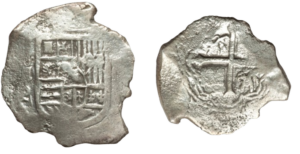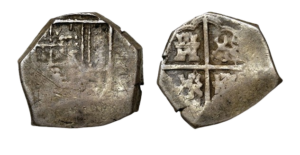9 December 2024
Though often overshadowed by other famous shipwrecks, the Nuestra Señora de la Concepción is one of the most significant Spanish galleon discoveries of modern times. In 1641, this treasure-laden ship departed from Cuba only to be overtaken by a powerful hurricane, scattering its cargo across the Silver Shoals. This article delves into the rich history of the ship, with a focus on Nuestra Señora de la Concepción shipwreck coins, including:
- Intriguing historical facts about the Concepcion ship
- The remarkable Concepcion treasure uncovered among the wreckage
- The best places to buy shipwreck coins online
For a deep dive into the Concepcion shipwreck, watch this fascinating video:
The Lost Treasure of Nuestra Señora de la Concepción: A Deep Dive
Facts about the Concepcion ship
Often compared to the Atocha shipwreck, the Nuestra Señora de la Concepción has an equally captivating story. This section will answer the question “What happened to Concepcion ship?”. And, as we delve deeper into facts about this vessel, we will also explain how its remarkable treasure, much like the shipwreck coins Atocha produced, provides valuable cultural and economic insights into its time.
Size and appearance of the Spanish ship Concepcion
The Nuestra Señora de la Concepcion ship was a substantial 600-ton nao, i.e. a three-masted ocean-going sailing ship, that underwent significant modifications to serve as a galleon. Originally built in Havana in 1620 as a merchant vessel, it was later refitted in Spain with military and structural enhancements. These modifications transformed the merchant vessel into a formidable armed galleon capable of protecting valuable cargo.
While exact dimensions aren’t provided in historical records, its 600-ton size and galleon configuration would have made it an imposing vessel, with the high fore and aft castles characteristic of Spanish naval architecture of the time.
La Concepcion ship route
As part of the Spanish Treasure Fleet system, the Concepcion ship operated on the vital trade route between Spain and its New World territories. The ship would typically sail from Spain to Veracruz, Mexico, transporting European goods and passengers, then return with precious metals and other valuable cargo.
The vessel’s final journey began in Cadiz on April 24, 1641, as Capitana (flagship) of the New Spain Fleet. After reaching Veracruz, the ship remained there for a year before being ordered to return to Spain, this time as Almiranta (vice-flagship). The return route took it to Havana, where it made a brief stop despite needing repairs. From there, the intended route was to join the fleet’s standard path across the Atlantic back to Spain, but deteriorating conditions and poor repairs would prevent the ship from completing this final voyage.
Concepcion shipwreck 1641
After departing Havana in poor condition, the Concepción met with fierce weather that proved catastrophic. Massive waves reached the height of the stern light, forcing water through the ship’s portholes. The vessel’s integrity quickly deteriorated as the stern’s caulking began failing. The main and fore masts snapped in the tempest, and the ship lost two anchors and three boats. A desperate attempt to continue using jury-rigged sails failed when the ship struck a reef about 60 miles north of Hispaniola.
In the ensuing chaos, one longboat carrying 32 high-ranking passengers and officers, including Vice-Admiral Villavicencio, managed to escape. Others attempted survival on eight makeshift rafts constructed from ship timbers. Of the 532 people aboard, only 194 survived. Twenty-five men remained with the treasure on the reef, but only one of these ultimately survived the wreck of the Concepcion.
Concepcion shipwreck 1715
The 1641 Concepción wreck should not be confused with the 1715 Spanish Treasure Fleet disaster. This confusion sometimes arises because both events involved Spanish treasure ships and resulted in significant losses. The 1715 fleet was a separate incident where an entire Spanish treasure fleet was lost in a hurricane off Florida’s east coast, while the 1641 Concepción was a single ship that went down off Hispaniola (modern-day Dominican Republic). Both wrecks have attracted treasure-hunting expeditions, leading to conflated histories, but research on “Concepcion shipwreck 1715” will yield no relevant results.
Concepcion shipwreck location
The Concepción’s remains lie off the northern coast of the Dominican Republic, near Puerto Plata, where it struck a reef on the Silver Bank. The wreck remained lost until William Phipps’ successful salvage operation 45 years after sinking, when his team recovered over 25 tons of silver.
The site was later sought by various explorers including Korganoff in 1952, Ed Link in 1958, and Jacques Cousteau in 1968. The definitive modern rediscovery came in 1978 by Burt Webber and Jack Haskins of Seaquest International Inc., aided by Peter Earle’s discovery of the Henry sloop’s logbook from Phipps’ expedition.
The Nuestra Señora de la Concepcion shipwreck location consists of two distinct areas separated by 150 meters, identified through aerial photography of the north reef of the Silver Bank and underwater magnetometer surveys.
The most famous Concepcion coins
Among the most fascinating artifacts recovered from the Concepción wreck were thousands of silver coins, offering a remarkable snapshot of Spanish colonial coinage from the early 17th century. The recovered numismatic treasure mostly included reales dating from 1600 to 1641, minted across the Spanish Empire’s key colonial facilities in Mexico, Cartagena, Santa Fé, and Potosí.
Notably, over three-quarters of the coins were minted in the three years immediately preceding the shipwreck (1639 -1641). The coins listed below provide invaluable insights into the Spanish Empire’s monetary system and colonial trade networks during this pivotal period.
- Felipe IV 8 Reales from the Concepcion wreck
Minted at the Mexico Mint, which was established in 1536 as the first mint in the Americas, this 8 reales coin is a significant artifact of Spanish colonial currency. Often referred to as a “pieces of eight”, these coins were one of the most widely circulated forms of currency in the Americas and international commerce, known for their consistent weight and fineness. Today, they are valued highly as rare Mexican coins.
Under King Felipe IV’s reign, the coins’ design featured the Spanish coat of arms on the obverse and the Pillars of Hercules with the motto “PLUS ULTRA” on the reverse. The unique “M” with a small cross above it, known as the Macuquin, distinguished these coins from others minted elsewhere.
Felipe IV 8 Reales
- Metal: Silver
Year: 1634-1641

- Philip IV 4 Reales from the Concepción ship
Part of the treasure of the Concepcion, this Philip IV 4 reales coin highlights the minting quality of the Mexico Mint during the 17th century. While only half as valuable as the piece of eight, this smaller denomination played a crucial role in everyday transactions in New Spain. Considered stunning coins both then and now, these pieces typically displayed clearer strikes than their South American counterparts due to the Mexico City Mint’s superior equipment and more experienced craftsmen.
Philip IV 4 Reales
- Metal: Silver
- Year: 1622-1641

Photo by Numista
- Cartagena Mint 4 Reales Coin from the wreck of the Concepcion
This 4 reales 1641 Concepcion shipwreck coin is particularly rare, as the minting facility it was produced by only began operations in 1621. The Cartagena Mint in Colombia was established to convert South American silver into coinage closer to the source. The Concepción coins include some of the earliest known examples from this mint, making them historically significant. Under Philip IV, these coins were struck during a period when Cartagena served as a crucial Caribbean port for the Spanish treasure fleet system.
Philip IV 4 Reales
- Metal: Silver
- Year: 1627 – 1630

- Philip III 2 Reales from the Concepcion shipwreck
The Potosí 2 reales found on the Concepcion treasure ship were minted at the world’s most productive silver mint, sitting high in the Andes Mountains. During the 1630s, these coins were produced under strict quality controls implemented after the great scandal of 1617-1619, when it was discovered that coins had been debased. Assayer Juan Ximénez de Tapia oversaw production during this period, marking his coins with a distinctive “T” assayer mark. These smaller denomination coins were crucial for regional trade within the Viceroyalty of Peru and represent the reformed minting practices of the post-scandal era.
Philip III 2 Reales
- Metal: Silver
- Year: 1617-1621

Photo by Numista
- Bolivian 8 Reales from the Nuestra señora de la Concepción shipwreck
This 8 reales coin recovered from the ship Concepcion is a testament to the Potosí Mint’s role in producing high-quality silver coins during the 17th century. These coins were minted using silver from the legendary Cerro Rico mine, known as the “mountain that eats men” due to its harsh working conditions. During Philip IV’s reign, these large silver coins showed improved quality following the mint’s reform, featuring better-centered strikes and more consistent weight than earlier issues.
Philip IV 8 Reales (Bolivia Mint)
- Metal: Silver
- Year: 1622

Photo by NGC
To see more exceptional specimens, beyond Concepcion coins, click here.
Where to buy rare coins
The story of the Concepción is a captivating chapter in the history of Spanish colonial maritime trade and exploration. The ship’s 1641 sinking off Hispaniola, while devastating, has left an incredible cultural legacy preserved in the thousands of coins and other artifacts recovered from the wreck site over the centuries. These numismatic treasures provide unparalleled insight into the monetary systems, trade networks, and economic realities that powered Spain’s global empire during the reigns of Philip III and Philip IV.
Those interested in acquiring rare coins, including specimens from shipwrecks, will find that Blanchard is an excellent choice. Known for its expertise in numismatics and outstanding customer service, Blanchard offers a curated selection of authentic coins of the highest quality. Blanchard’s knowledgeable team is available at all times to answer your questions about Concepcion coin value and more!
Want to read more? Subscribe to the Blanchard Newsletter and get our tales from the vault, our favorite stories from around the world and the latest tangible assets news delivered to your inbox weekly.
The post The Concepcion Shipwreck: The Sad Story Behind the Amazing Coins appeared first on Blanchard and Company.